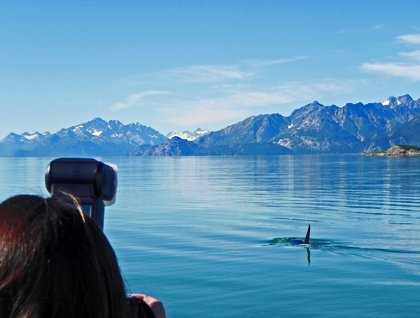Our day in Glacier Bay began with glorious blue skies and sunshine. Because we picked up Chelsea, our Glacier Bay ranger, and William, our Huna cultural interpreter, at 9 p.m. last night, we were able to enter the park at midnight and cruise all the way to Johns Hopkins Inlet at the upper end of the bay by the time we got up in the morning.
What an incredible view greeted us as we came on deck! The Johns Hopkins Glacier rose 250 feet out of ice-bedecked water and 10,000-foot snowy peaks ringed the glacier. We watched as several small pieces of ice fell, creating a sound like thunder that the Tlingits called “sumdum.” The small sumdums preceded much larger slabs of ice that also created a wall of spray and shock waves in the water that actually rocked our ship. The process of ice falling from the front of a glacier is given the curious name “calving,” supposedly because the glacier drops ice like a cow drops a calf.
We continued down the bay looking for wildlife and at Gloomy Knob spotted an eagle on a tree with a nest containing a fledgling just above waterline. Goats were also seen keeping cool in the high mountain snowfields. After lunch Chief Engineer Hector, Head Chef Ryan and Chief Mate Billy revealed some of the secrets of keeping the National Geographic Sea Lion running smoothly and effectively. Also, William gave us a very special individualized account of his Tlingit heritage and Chelsea provided bird identification lessons.
We also found the wildlife. Several killer whales swimming close to the ship was one of the highlights. We worried about sea otters nearby, but the killer whales apparently had other prey on their minds. At South Marble Island we had a really close look at sea lions, sea otters, and a multitude of birds, including tufted and horned puffins.
Our amazing Glacier Bay experience ended with a hike through an old growth forest that has grown where glacial ice was flowing just 250 years ago. The last attraction was the historic Glacier Bay Lodge with a knockout view of a brilliant sunset and alpenglow on the Fairweather Range.







